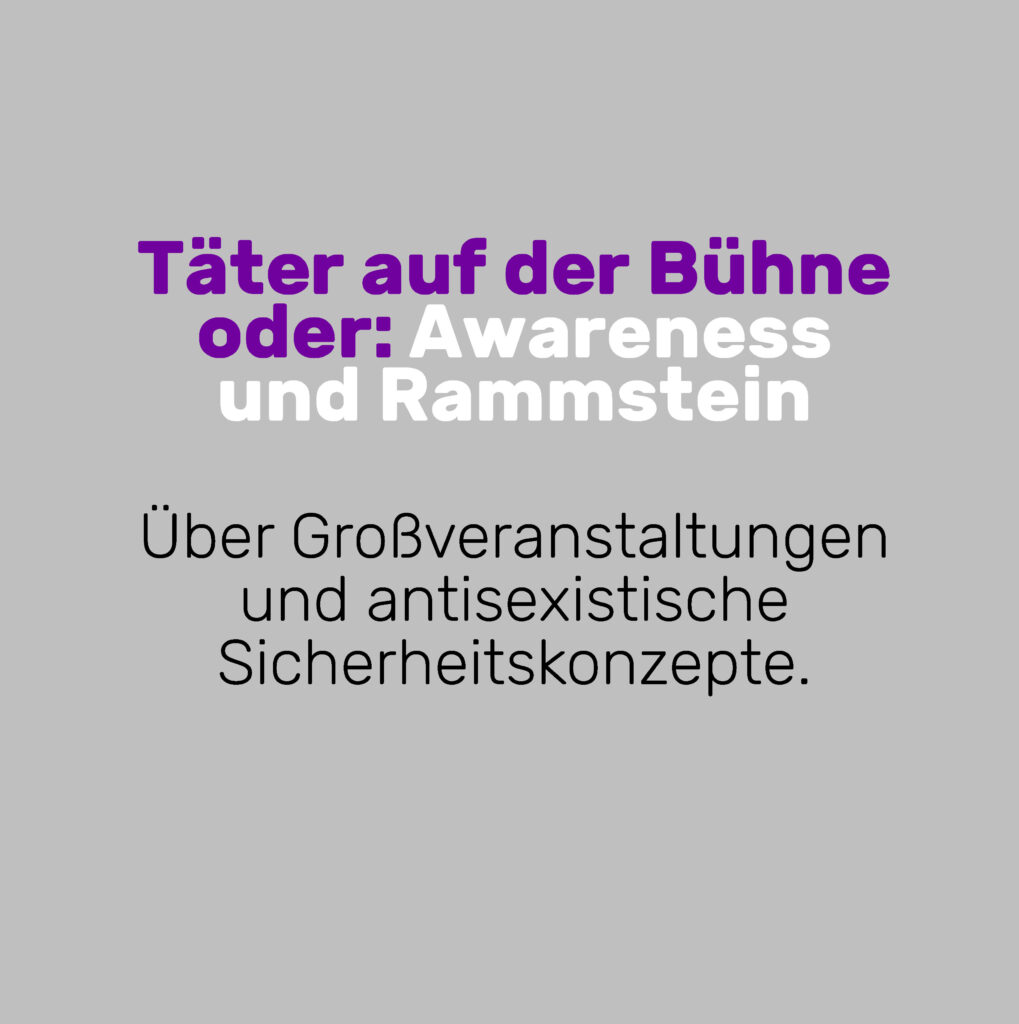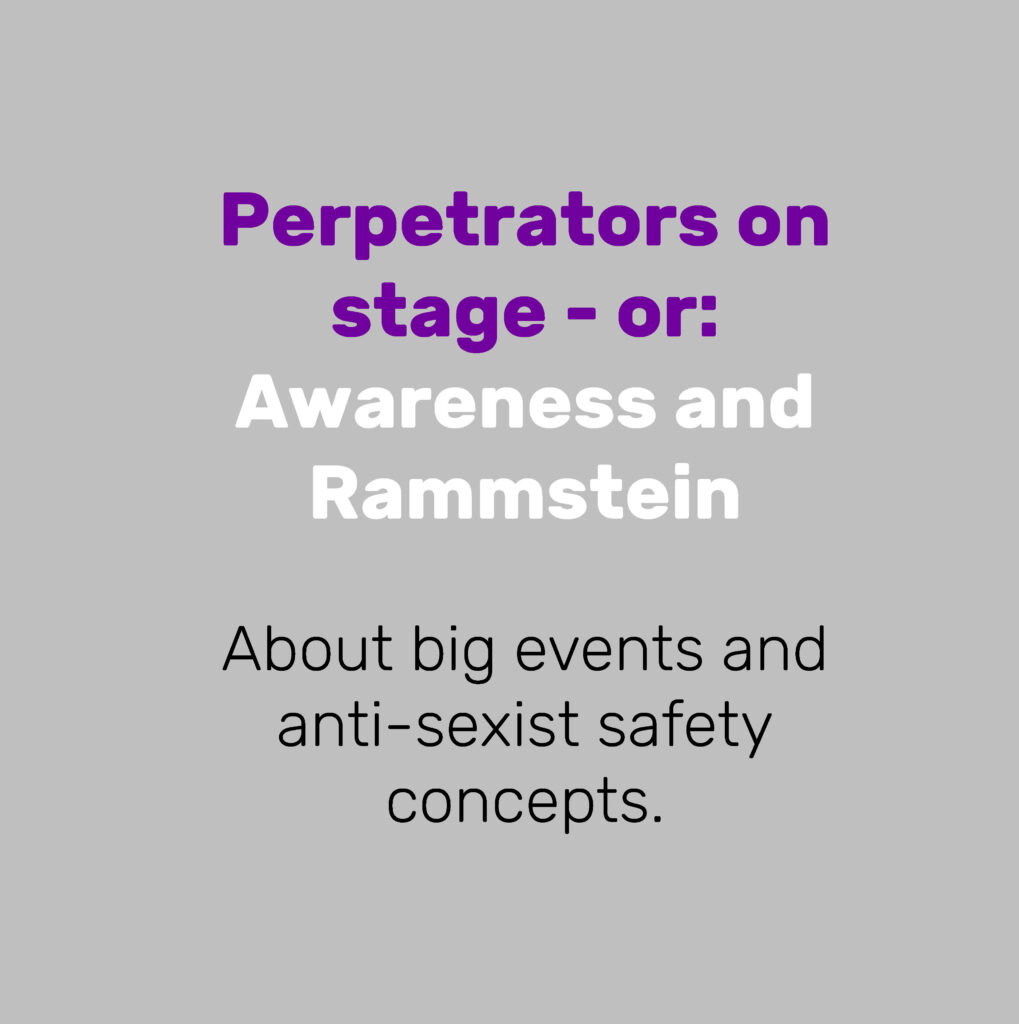english version see below

Täter auf der Bühne – oder: Awareness und Rammstein – Über Großveranstaltungen und antisexistische Sicherheitskonzepte.
Seit die Übergriffsvorwürfe gegen den Sänger der Band Rammstein publik geworden sind, ist auch Awareness und damit verbundene Konzepte ein Thema, das in vielen medialen Berichten aufkommt. Zuletzt hat auch die Band selbst angekündigt, ein “Awarenesskonzept” bei ihrem nächsten Auftritt umzusetzen. Das ist aus unserer Sicht in der aktuellen Situation ein grundsätzlich falscher Zugang zu Awarenessarbeit und ist als Awarenesswashing zu verstehen. Warum führen wir hier im Text aus!
Awareness ist ein Konzept, das klaren Richtlinien und Werten folgt.
Zu diesen Richtlinien gehören die Prinzipien von Definitionsmacht und Parteilichkeit, sowie dass sich Betroffene (Personen die von Gewalt und Diskriminierung betroffen sind) vertraulich an die jeweilige Struktur wenden können.
Das bedeutet, die Realität der Betroffenen und ihre Erfahrungen anzuerkennen.
Es bedeutet, sich auf die Seite dieser Menschen zu stellen.
Und gemeinsam zu überlegen, wie gemeinsam mit diesen Personen Handlungsfähigkeit (wieder) hergestellt und Unterstützung gegeben werden kann.
Prinzipiell ist es eine gute und notwendige Sache für Veranstaltungen, egal welcher Größe, Konzepte zu haben, die regeln, was passiert, wenn es Übergriffe gibt.
Awarenessarbeit bietet dabei einen Rahmen, der klar absteckt, was vor allem Betroffene an Unterstützung erwarten können und dass ihre Anliegen wahrgenommen und ernst genommen werden. Diese Konzepte können in der Praxis dann unterschiedlich umgesetzt werden (was die Verankerung vor Ort etc. betrifft), aber Merkmale wie, dass es bei großen Veranstaltungen ein klar erkennbares, gut und direkt erreichbares, direkt ansprechbares, gut geschultes Team vor Ort gibt gehören dazu. Dieses Team hat auch das Hausrecht und kann im Zweifelsfall zum Schutz der betroffenen Personen die Verursachenden der Veranstaltung verweisen und handelt nach den zu Awarenessarbeit dazugehörigen und oben benannten Prinzipien.
Was passiert also im Fall von Rammstein, wenn der Verursacher, also der Täter, auf der Bühne steht? Das Awareness Team müsste als Erstes den Sänger vom Konzert verweisen. Wenn sie das nicht täten, würden sie gegen die Prinzipien verstoßen, vor allem nach dem, was von den Betroffenen öffentlich gemacht wurde. Dazu gehört auch, dass geäußert wurde, ist, dass es eine Klärung der Fälle und deine Verantwortungsübernahme durch die Band (oder andere Strukturen wie Label, Management, etc.) braucht.
In einem solchen Kontext und einer solchen Situation kann ein Konzert nicht sicher gemacht werden, auch nicht durch eine Awareness-Struktur. Denn das Problem und der Verursacher sind weiterhin zentral präsent. Es hat den Anschein, dass die Band durch diese Maßnahmen von dem Geschehen ablenken, ja die Berichte über das, was passiert ist, sogar relativieren will. Durch ein Awarenesskonzept soll so suggeriert werden, dass es eine Sensibilität für das Thema gibt. Aus Sicht unserer Arbeit würde das aber bedeuten konsequent zu handeln, die Vorwürfe zu klären und bis dahin die Zusammenarbeit mit dem Sänger zu beenden. Es würde bedeuten, die Vorwürfe ernst zu nehmen, statt wie in diesem Fall Awarenesswashing zu betreiben.
Awarenesswashing ist nicht erst seit Rammstein ein Thema. Wenn, wie im Fall der „Bucht der Träumer“ (https://awa-stern.info/solidaritatsbekundung-und-kritik-an-den-festivalorganisatorinnen-der-bucht-der-traumer/), zentral verantwortliche Personen die Verursacher, also die Täter, schützen und dann die Betroffenen die Struktur verlassen müssen, oder sich auch an den Orten der Veranstaltung in Folge nicht mehr sicher fühlen würden, dann widerspricht das allen Grundlagen von Awareness.
Die Regeln und Prinzipien gelten für alle. Wenn das nicht der Fall ist, dann ist es nicht Awareness. Veranstalter_innen, Musiker_innen, Club und Locationbesitzer (ein Wort, das aufgrund der großen Männerdominanz in diesem Bereich selten geschlechterdivers geschrieben werden muss), Organisator_innen, Moderation, Securitypersonen, Techniker_innen und andere, die innerhalb einer solchen Struktur Verantwortung und Repräsentationsrollen innehaben, oder Teile von Arbeit übernehmen sind von den Vereinbarungen, die im Rahmen von Awarenesskonzepten getroffen werden, nicht ausgenommen.
Denn entweder gilt es für alle und alle können sich darauf verlassen, oder es gilt nicht. Und gerade wenn Vorwürfe und Übergriffe von Personen kommen, die Macht haben, dann braucht es eben noch mehr diese Sicherheit.
Das beinhaltet auch die Sicherheit, dass Betroffene anonym bleiben. Mehr noch, dass, nur wenn sie es explizit wollen ihre Geschichte öffentlich gemacht wird und das nur auf ihren expliziten Wunsch hin und nach gemeinsamer Beratung über Strategie und Sicherstellen einer Supportstruktur für Betroffen und ihr Umfeld.
Wenn es dann schon ein Vorwurf oder Vorwürfe im Raum gibt (egal ob anonym oder nicht, egal ob öffentlich oder direkt an Verantwortliche kommuniziert), dann müssen diese erst einmal aufgearbeitet werden. Weiterzumachen und dann Pseudo-Awareness darüber zu streuen und zu sagen, „wir sind eh nicht mehr übergriffig und machen jetzt ein anderes Konzept“, reicht dann nicht aus, sondern delegitimiert auch die Betroffenen. Dabei ist auch nicht das „künstlerische Konzept“ oder ein sonst wie höherer Zweck Grund, sich über die Wünsche und Forderungen von Betroffen zu stellen. Von dem Kunstwerk und den Personen die dahinterstehen, kann im Moment eines Auftrittes nicht getrennt werden. Denn dabei passiert auf der Bühne die Situation, dass sich der Täter zeigen kann, während eben Betroffene das nicht gleichermaßen können.
Statt Awareness braucht es in diesem Fall, dass die Band alle weiteren Auftritte absagt und erst einmal ihre internen Verhältnisse, Werte und dergleichen klärt und sich überlegt, ob sie mit der verursachenden Person weiter zusammenarbeiten will. Es ist aber auch schwer vorstellbar, dass bei diesen Vorgängen die anderen Bandmitglieder und andere mit der Struktur vertraute Personen jahrelang nichts von den Vorfällen mitbekommen haben. Auch das mediale Vorgehen der Band scheint dies zu bestätigen, denn statt klarer Ansagen wird die Verantwortung auf andere geschoben. Dabei wird von der Band Betroffenen geraten nichts zu veröffentlichen, Anwälte agieren gegen Berichterstattung und die von der Band beauftragte Krisenagentur für PR rät ihnen wahrscheinlich da jetzt was mit “Awareness” zu machen. Dafür lassen wir uns nicht instrumentalisieren.
Wenn die Band es also nicht selbst tut und den Täter schütz oder vielleicht auch durch ihr Handeln mit zu Gesehenen beigetragen hat, dann ist es an allen anderen, gemeinsam dafür zu sorgen, dass Täter keine Bühne bekommen. Das ist dann jedenfalls richtige und angewandte Awareness-Arbeit.
Mehr zu den Grundsätzen und Hintergründen unserer Arbeit finden sich hier:
https://awa-stern.info/grundsatz/
https://awareness-institut.net/tools-der-awareness-arbeit/
_____________

Perpetrators on stage – or: Awareness and Rammstein.
About big events and anti-sexist safety concepts.
Since the claims of assault against the singer of the band Rammstein became public, awareness and related concepts have been a topic in many media reports. Recently, the band itself announced that it would implement an „awareness concept“ at its next performance. In our view, this is a fundamentally wrong approach to awareness work in the current situation and should be understood as awareness washing. We will explain why here in the text.
Awareness is a concept that follows clear guidelines and values.
These guidelines include the principles of the power of definition and partisanship, as well as the fact that those affected (persons affected by violence and discrimination) can turn to the corresponding structure confidentially.
This means recognizing the reality of the affected persons and their experiences.
It means taking the side of those affected.
And to find out together with them how to (re)create the ability to act and how to give support.
In principle, it is a good and necessary thing for events, no matter what size, to have concepts that manage what happens when there are assaults.
Awareness work offers a framework that clearly defines what support can be expected, especially by those affected, and that their concerns are taken seriously. In practice, these concepts can be implemented in different ways (in relation to local structures, etc.), but they include features such as a clearly recognizable, easily and directly accessible, directly approachable, well-trained team on-site at large events. This team also has the authority of the premises and, in case of doubt, can exclude the perpetrators from the event for the protection of the persons affected and acts according to the principles associated with awareness work as mentioned above.
So what happens in the case of Rammstein when the person creating the harm, the perpetrator, is on stage? The awareness team would first have to expel the singer from the concert. If they didnt do that, they would be going against the principles, especially after what has been made public by those affected. This includes the fact that it has been expressed that there needs to be a clarification of the cases and that the band (or other structures like label, management, etc.) should take responsibility.
In such a context and situation, a concert cannot be made safe, not even through an awareness structure. Because the problem and the perpetrator are still centrally present. It seems that the band wants to use these measures to distract from what happened, even to relativize the reports about what happened. Through an awareness concept, it is supposed to be suggested that there is a sensitivity to the issue. From the point of view of our work, however, this would mean taking consistent action, clarifying the accusations and, until then, terminating the cooperation with the singer. It would mean taking the allegations seriously instead of awarenesswashing as in this case.
Awarenesswashing has not only been an issue since Rammstein. If, as in the case of the “ Bucht der Träumer“ (Bay of Dreamers) (https://awa-stern.info/solidaritatsbekundung-und-kritik-an-den-festivalorganisatorinnen-der-bucht-der-traumer/), centrally responsible persons protect the persons responsible, i.e. the perpetrators, and then those affected are forced to leave the structure, or as a result would no longer feel safe at the event locations either, then this goes against all the foundations of awareness. The rules and principles apply to everyone. If this is not the case, then it is not awareness. Organizers, musicians, club and venue owners, facilitators, security people, technicians and others who have responsibilities and representational roles within such a structure, or take on parts within the work, are not excluded from the agreements that are made within the framework of awareness concepts.
Because either it applies to everyone and everyone can rely on it, or it does not. And especially when accusations and assaults come from people who have power, then this certainty is needed even more.
This also includes the certainty that those affected will remain anonymous. Even more, their story is only made public if they explicitly want it to be, and only at their explicit request and after joint consultation on strategy and ensuring a support structure for those affected and their environment.
If there is already an accusation or accusations in the room (whether anonymous or not, whether communicated publicly or directly to those responsible), then these must first be dealt with. Continuing and then sprinkling pseudo-awareness over it and saying, „We are no longer committing assaults anyway and are now doing a different concept“ is then not enough, but also delegitimizes those affected. Nor is the „artistic concept“ or any other higher purpose the reason for placing oneself above the demands of those affected. The work of art and the individuals behind it cannot be separated at the moment of performance. Because what happens on stage is that the perpetrator can show himself, while those affected cannot do the same.
Instead of awareness, what is needed in this case is for the band to cancel all further gigs and first clarify their internal relationships, values, and the sort of thing, and consider whether they want to continue working with the person causing the harm. However, it is also hard to imagine that the other band members and other people familiar with the structure would have been unaware of these incidents for years. The bands media approach also seems to confirm this, because instead of clear announcements, responsibility is shifted onto others. The band advises those affected not to publish anything, lawyers act against reporting, and the PR agency commissioned by the band probably advises them to do something with „awareness“. We wont be instrumentalized for that.
So if the band doesnt do it themselves and protect the perpetrator or perhaps also contributed to what happened through their actions, then its up to everyone else to work together to ensure that perpetrators dont get a stage. Thats proper and applied awareness work then.
More about the principles and background of our work can be found here: